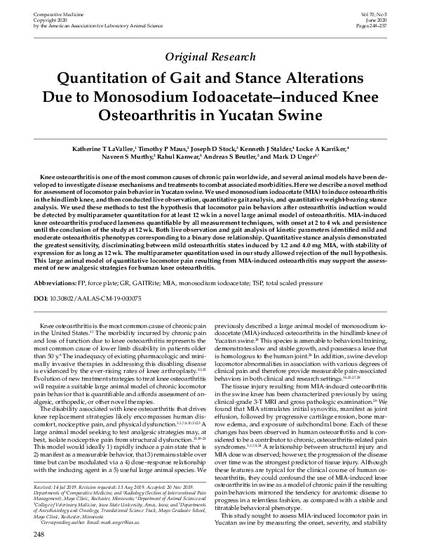
Knee osteoarthritis is one of the most common causes of chronic pain worldwide, and several animal models have been developed to investigate disease mechanisms and treatments to combat associated morbidities. Here we describe a novel method for assessment of locomotor pain behavior in Yucatan swine. We used monosodium iodoacetate (MIA) to induce osteoarthritis in the hindlimb knee, and then conducted live observation, quantitative gait analysis, and quantitative weight-bearing stance analysis. We used these methods to test the hypothesis that locomotor pain behaviors after osteoarthritis induction would be detected by multiparameter quantitation for at least 12 wk in a novel large animal model of osteoarthritis. MIA-induced knee osteoarthritis produced lameness quantifiable by all measurement techniques, with onset at 2 to 4 wk and persistence until the conclusion of the study at 12 wk. Both live observation and gait analysis of kinetic parameters identified mild and moderate osteoarthritis phenotypes corresponding to a binary dose relationship. Quantitative stance analysis demonstrated the greatest sensitivity, discriminating between mild osteoarthritis states induced by 1.2 and 4.0 mg MIA, with stability of expression for as long as 12 wk. The multiparameter quantitation used in our study allowed rejection of the null hypothesis. This large animal model of quantitative locomotor pain resulting from MIA-induced osteoarthritis may support the assessment of new analgesic strategies for human knee osteoarthritis.
Available at: http://works.bepress.com/kenneth_stalder/243/

This article is published as LaVallee, Katherine T., Timothy P. Maus, Joseph D. Stock, Kenneth J. Stalder, Locke A. Karriker, Naveen S. Murthy, Rahul Kanwar, Andreas S. Beutler, and Mark D. Unger. "Quantitation of Gait and Stance Alterations Due to Monosodium Iodoacetate–induced Knee Osteoarthritis in Yucatan Swine." Comparative Medicine 70, no. 3 (2020): 248–257. DOI: 10.30802/AALAS-CM-19-000075. Posted with permission.